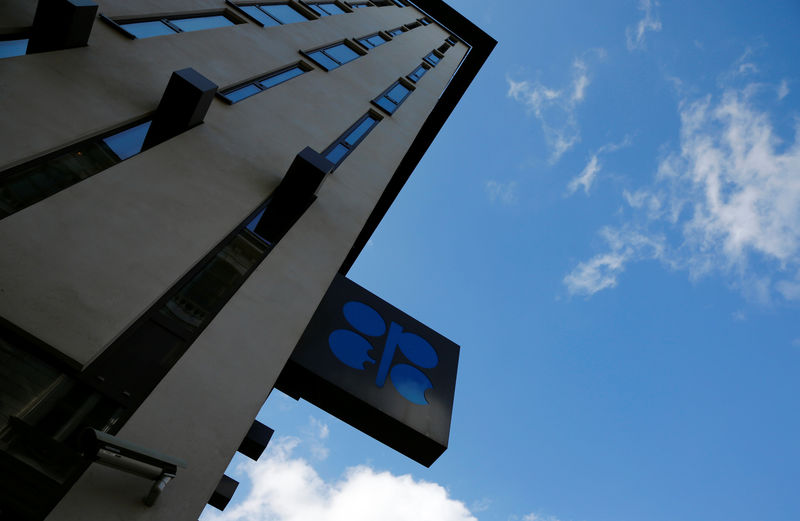(Bloomberg) -- The deal OPEC struck in 2016 to clear a global glut by halting a significant chunk of oil production took almost a year of bargaining and brinkmanship. By year-end, the group may have lost the same amount of crude unintentionally.
The Organization of Petroleum Exporting Countries is already cutting daily production by much more than its pledged 1.2 million barrels. Venezuela’s economic crisis is battering its oil industry and pushing output to the lowest level in decades, with a further decline likely. If U.S. President Donald Trump also reimposes sanctions on Iran, the cartel’s unplanned losses could swell to double the targeted cut.
That would pose a dilemma for Saudi Arabia and Russia, the leaders of the cuts agreement. Should they let the oil market get even tighter, but run the risk that higher prices hurt demand or spur an even bigger wave of American shale-oil? Or should they fill the gap by increasing production, but in the process unravel their historic agreement prematurely?
“When we think about the year end, it’s Iran in combination with Venezuela,” said Helima Croft, head of commodity strategy at RBC Capital Markets LLC in New York. “We could have a snap-back in U.S. sanctions on Iran. In Venezuela, it’s a slow bleed -- the losses just keep adding up.”
Venezuelan Slump
Saudi Arabia and Russia, for years oil-market rivals, assembled a coalition of 24 OPEC nations and non-members to eliminate the surplus created by the U.S. shale boom. The accord has exceeded expectations. Excess inventories will be gone in two to three months, according to the International Energy Agency, and Brent crude prices are above $70 a barrel, the highest in three years.
The collapse of Venezuela’s oil industry has aided the wider group’s efforts. The nation’s daily production of 1.5 million barrels is 560,000 barrels lower than October 2016 -- the starting point specified in the cuts agreement. That’s more than five times its pledged reduction.
The Latin American country’s economic crisis shows no sign of abating and output may slump to 1.1 million barrels a day by the end of the year, according to consultant Rapidan Energy Group in Washington. The decline will be even steeper if the U.S. follows through on threats to impose new sanctions after elections scheduled for May, Rapidan said.
Iran Sanctions
The loss of that much Venezuelan crude would tighten oil markets significantly more than OPEC and its allies intended. The growing tensions between the U.S. and Iran could make the supply deficit even more severe.
Next month, President Trump will review America’s commitment to an international agreement that restricted Iran’s nuclear activities in exchange for relief from sanctions. He has been fiercely critical of the accord and recently fired top officials who were supportive of the deal, replacing them with more hostile figures.
There’s a 70 percent likelihood that Trump will abandon the pact and reintroduce sanctions on oil sales, said Mike Wittner, head of oil market research at Societe Generale (PA:SOGN) SA. That would curb Iran’s exports by about 500,000 barrels a day, he estimates.
Under the terms of the 2016 OPEC deal, Iran didn’t have to reduce production because it was still recovering from the last round of international sanctions. So a half-million-barrel drop in its output, combined with the loss of 900,000 barrels a day of Venezuelan crude beyond its pledged reduction, would double the group’s intended cut.
High Risk
The situation in both countries is highly uncertain and the direst predictions may not be fulfilled. America’s European allies are keen to preserve the accord with Iran, which could mean the impact of renewed U.S. restrictions on oil sales would be limited, said Olivier Jakob at consultants Petromatrix GmbH in Zug, Switzerland. Venezuela’s state oil company has so far managed to avoid defaulting on its debt, although it shows no sign of having the resources required to reverse the slide in production.
Still, the likely outcome is that OPEC’s efforts to tighten the market will go further than intended and “the inventory draw will be more than the target,” said Ed Morse, head of commodities research at Citigroup Inc (NYSE:C). in New York.
That would give Russia and Saudi Arabia the dilemma of whether to continue restraining production or restore it. It’s not clear which they would choose.
Before OPEC and Russia agreed to extend their cuts last year, Moscow voiced concerns that letting prices rise too high would only stimulate more production in the U.S.. More recently however, Energy Minister Alexander Novak echoed Saudi support for continuing the curbs until the end of 2018 as planned and spoke of the cooperation lasting indefinitely.
Maintaining the cuts and allowing a significantly tighter market would align with Saudi Arabia’s desire for an oil price of about $80 a barrel to support the valuation of Aramco before an initial public offering. Yet it may also be inclined to boost output to take market share from regional antagonist Iran, just as it did in the last round of sanctions in 2012.
“Saudi Arabia increased its production the last time Iran was under sanctions,” said Eugen Weinberg, head of commodities research at Commerzbank AG (DE:CBKG) in Frankfurt. “Is it going to be different this time around?”
